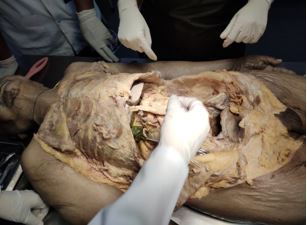An anatomical approach to Grahani on the basis of Cadaveric Dissection - A Cadaveric Case Study
Abstract
Ayurveda is the ancient medical science of the world. It is first focuses on maintain health of human beings. Maintaining of health by proper using of Ahara (diet), Vihara (daily routine). Ahara or Anna are maintain health by proper metabolism, Ahara known as Prana. In Ahara Paka (digestion) take place in different stage at different parts of body. In this process Grahani is the special part of digestion system part and it is the specialized part of the Mahasrotas. Pittadara Kala is situated at the site of the site of the Grahani, and also site of the Pachaka Pitta which help in the the Ahara Pachana. According to Ayueveda the 6th Pittadhara Kala is situated in between the Amashaya and Pakwashaya and situated above the Nabhi. Grahani is the site of Agni and does Grahana of Anna and it is supported and nourished by the strength of Agni. This study is an attempt to elaborate and compare both ancient and modern concept of Grahani and its clinical significance with the help of cadaveric study.
Downloads
References
Shastri Ambikadutta, Sushruta Samhita Ayurveda Tattva Sandipika, 1st edition Varanasi: Chaukhambha Sanskrit Sansthan; 2104. Vol. I, Su. Sharir 4/18 page 40.
Tortora Gerard J & Grabowski Sandra Reynolds. Principles of Anatomy and Physiology:eighth edition,1996.Chapt24.p783
Patrick W. Tank, Grant’s dissector 15th edition, Lippincott Williams & Wilkins, a Wolters Kluwer business, Two Commerce Square, 2001 Market Street Philadelphia, PA 19103, page-107.
Shastri Ambikadutta, Sushruta Samhita Ayurveda Tattva Sandipika, 1st edition Varanasi: Chaukhambha Sanskrit Sansthan; 2104. Vol. I, Su. Sutra 21/5 page 112.
Kaviraj Atridev Gupta, Astang hradaya , Vidyotini hindi Commentary,edition 2018 Chaukhamba prakashan 2018,astang hradaya sutra- 12/10 Page-121.
Shastri Ambikadutta, Sushruta Samhita Ayurveda Tattva Sandipika, 1st edition Varanasi: Chaukhambha Sanskrit Sansthan; 2104. Vol. I,Su. Sutra 21/10 page 115.
Bynarjee Dheku. Parishabdha shabdhartha shariram. Ayurveda Sharira Prusta 282.

Copyright (c) 2023 Arvind Kumar Yadav, Rita Marwaha, Pankaj Gupta, Niraj Gole, Ravindra Singh Baghel

This work is licensed under a Creative Commons Attribution-NonCommercial-ShareAlike 4.0 International License.
Journal of Ayurveda and Integrated Medical Sciences (JAIMS) retains the copyright of the contents of this journal but grant the readers the right to use the contents with terms and conditions under a creative common attribution licenses 4 of Attribution, Share Alike and Non-commercial type (CC BY-NC-SA) that allows copy, distribute, display, and perform the work and make derivative works based on it only for non-commercial purposes.

This work is licensed under a Creative Commons Attribution-NonCommercial-ShareAlike 4.0 International License.












